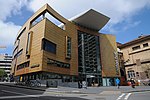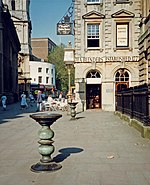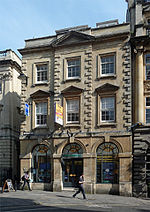The Centre, Bristol

The Centre is a public open space in the central area of Bristol, England, created by covering over the River Frome. The northern end of The Centre, known as Magpie Park, is skirted on its western edge by Colston Avenue; the southern end is a larger paved area bounded by St Augustine's Parade to the west, Broad Quay the east, and St Augustine's Reach (part of the Floating Harbour) to the south, and bisected by the 2016 extension of Baldwin Street. The Centre is managed by Bristol City Council. The name 'The Centre' (or 'The City Centre') appears to have been applied to the area from the mid-twentieth century; before that, from 1893 when the upper part of St Augustine's reach was covered, it was known as the Tramways Centre and Magpie Park.The Centre is not the historic or civic centre of Bristol, nor is it a major shopping area. It is, however, an important local transport interchange and cultural destination. Many local bus services terminate at or pass through here, and it is also served by ferry services to Hotwells and Bristol Temple Meads station, and has busy taxi ranks. The Centre has been altered on a number of occasions, originally to ease traffic flow but latterly to try to strike a balance between its use as both public open space and an important traffic corridor. In 2017, alterations to accommodate the MetroBus bus rapid transit scheme were completed.
Excerpt from the Wikipedia article The Centre, Bristol (License: CC BY-SA 3.0, Authors, Images).The Centre, Bristol
Centre Promenade, Bristol City Centre
Geographical coordinates (GPS) Address Website External links Nearby Places Show on map
Geographical coordinates (GPS)
| Latitude | Longitude |
|---|---|
| N 51.454 ° | E -2.5972 ° |
Address
Centre Promenade
Centre Promenade
Bristol, City Centre
England, United Kingdom
Open on Google Maps









